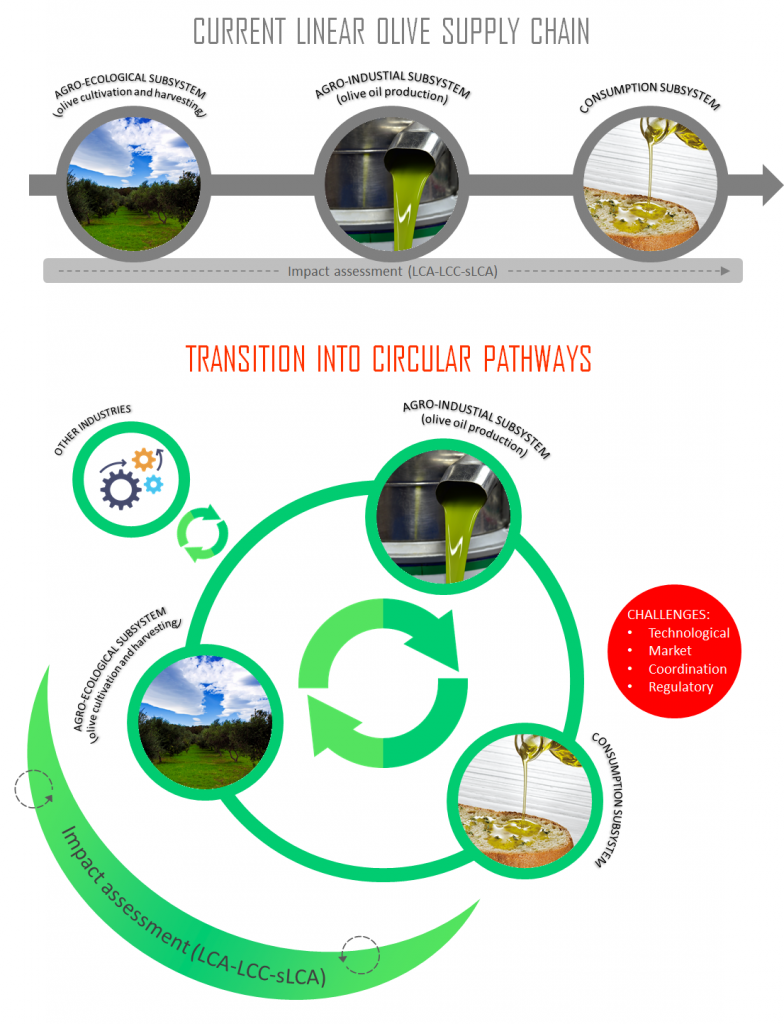DRASTIC analyses the agro-ecological, agro-industrial and consumption subsystems of olive oil production in Southern Italy. Research is undertaken in Apulia, Calabria, Sicily and Campania – the first four Italian regions for olive growing area –, where the olive oil industry causes important environmental impacts while offering opportunities for by-products valorization. Each subsystem will represent a work package (WP) of the project, in which alternative CE pathways will be analyzed against the challenges for the transition.

cierre
Involving UniNA
This WP concerns the coordination of the project as a whole, including reporting activities, project meetings and the interaction with stakeholders and the funding agency.
The objective of this WP is to assess the four transition challenges related to the agro-ecological subsystem. The ultimate objective is to trigger the adoption among farmers of circular technologies, business models, coordination strategies and to eliminate obstructing regulations for the adoption of CE pathways.
- Task 1.1: This task analyzes the current linear farming practices for olive cultivation and harvesting.
- Task 1.2: This task generates guidelines for the most appropriate CBM to promote the adoption of CE pathways at farm level.
- Task 1.3: This task focuses on attitude of olive growers towards CE and on organization elements. It examines farmers’ perception of barriers to participate in CE. It will also focus on the analysis of the critical organizational elements for the transition to CE at farm level.
- Task 1.4: This task focuses on the identification of relevant attributes of potential public policies and laws that may foster the transition to CE pathways at farm level.
WP2 assesses the four transition challenges related to the agro-industrial subsystem. The ultimate objective is to facilitate the adoption among entrepreneurs of technologies, business models, coordination strategies and to eliminate obstructing regulations for the adoption of CE pathways.
- Task 2.1: This task analyzes the current linear technological practices of olive oil production.
- Task 2.2: This task generates guidelines for the most appropriate CBM to promote the adoption of CE pathways at firm level.
- Task 2.3: This task focuses on attitude of olive oil producers towards CE and on organization elements. It examines entrepreneurs’ perception of barriers to participate in CE. It will also focus on the analysis of the critical organizational elements for the transition to CE at firm level.
- Task 2.4: This task focuses on the identification of relevant attributes of potential public policies and laws that may foster the transition to CE pathways at firm level.
This WP is aimed at assessing consumers’ willingness to participate in CE by buying food produced through CE initiatives. CE creates value by lending products extrinsic attributes related to the creation of sustainable agri-food systems. This WP seeks to find the conditions in which consumers can capture this value and support, through their purchase behavior, companies engaged in CE.
- Task 3.1: National survey. A national representative sample of households will be surveyed to identify the most preferred products/attributes/innovations combinations, as well as the most attractive market segments for circular products.
- Task 3.2: Framed field economic experiment. Non-hypothetical, incentive compatible framed field economic experiments will specifically analyze consumer perceptions, expectations, and preferences for the selected attributes stemming from task 3.1.
- Task 3.3: Natural field economic experiment. Non-hypothetical natural field economic experiments will be performed in real food shopping environments to verify consumer preferences for the selected products, under different information treatments.
WP4 focuses on implementing Life Cycle (LC) approaches to compare the observed linear production processes, with the alternative closed-loop pathways identified in WP1 and WP2. Through LC protocols, it is possible to test environmental, economic and social performances of CE solutions, validating assumptions and generating feedback for improvement. A life cycle sustainability assessment (UNEP/SETAC approach) concludes the analysis.
- Task 4.1: Environmental impact assessment: LCA (Life Cycle Assessment).
- Task 4.2: Economic Impact assessment: LCC (Life Cycle Costing) and eLCC (environmental Life Cycle Costing).
- Task 4.3: Social Impact Assessment: S-LCA (Social Life Cycle Assessment).
This WP ensures that the project results are disseminated in a way that they will continue to be deployed even after the end of the project.

